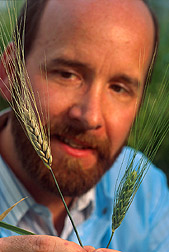This page has been archived and is being provided for reference purposes only. The page is no longer being updated, and therefore, links on the page may be invalid.
|
Read: about the research in Agricultural Research.. |
Researchers Test Yeast’s Anti-Scab MettleBy Ben HardinMay 31, 2001 A beneficial yeast is making its debut in the first wide-scale U.S. tests comparing effectiveness of biological and chemical controls for Fusarium head blight, also known as scab disease. Tests are under way in small experimental plots scattered across the eastern half of the United States. Scab is getting attention because losses attributed to it in the past decade have been estimated in excess of $3 billion to U.S. farmers. An obscure yeast called Cryptococcus nodaensis was chosen for the new tests through laboratory and field experiments. It and six runners-up were selected from nearly 1,000 yeasts and bacteria screened by plant pathologists with the Agricultural Research Service and Ohio State University. OSU and the U.S. Department of Agriculture have applied for a patent on the “magnificent seven” microbes. At the ARS National Center for Agricultural Utilization Research (NCAUR), at Peoria, Ill., David A. Schisler and his colleagues researched conditions needed to reproduce the best yeast at top speed. This spring, they supplied sufficient microbes for the Uniform Wheat Fungicide Trials. This cooperative project, funded by USDA through the U.S. Wheat and Barley Scab Initiative, will provide direct comparisons of scab control measures, in various environments, from year to year. The experiment stations involved include those of Arkansas, Indiana, Iowa, Kentucky, Maryland, Michigan, Minnesota, Missouri, New York, North Dakota, Ohio, South Dakota and Virginia. The researchers weighed their choices of microbes according to several considerations, one of which was the microbes’ resistance to registered and experimental fungicides. Other considerations included the microbes’ ability to grow on low-cost sources of carbon and nitrogen, their ability to survive and remain healthy in storage, and their effectiveness after storage in arresting the growth of Fusarium graminearum, the fungus that causes scab. For the field tests, the researchers grew C. nodaensis on a growth medium reminiscent of the corn steep liquor-based medium used in the 1940s at NCAUR in penicillin-production experiments that helped launch the antibiotics industry. ARS, the USDA’s chief scientific research agency, is seeking cooperators to speed development of the biological control technology. An article about the research appears in the June issue of ARS' Agricultural Research magazine. Scientific contact: David A. Schisler, ARS National Center for Agricultural Utilization Research, Peoria, Ill., phone (309) 681-6567, fax (309) 681-6427, schislda@mail.ncaur.usda.gov. |

